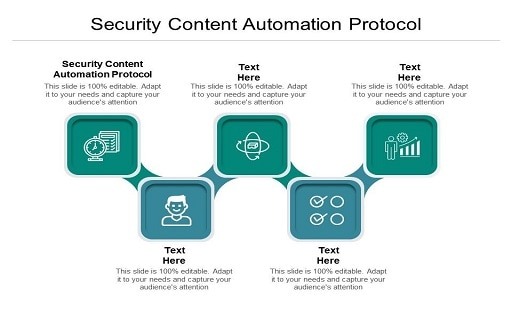Security Content Automation Protocol: Are you having trouble keeping track of all of the vulnerabilities that exist within your system? The moment you conclude that you have found a solution to one problem, another one appears.
Cybersecurity enforcement is a never-ending race. Therefore, take a deep breath and relax by having SCAP automate your defensive strategies. You’ll learn more about the standard security framework, its components, and the benefits of using it in the following section.

What is a Security Content Automation Protocol (SCAP)?
The Security Content Automation Protocol, also known as SCAP, is a standardized system that assists you in automating the process by which you identify the vulnerabilities present in your system and ensures that you are in compliance with the existing security requirements in your industry.
There are literally hundreds of different online dangers out there. Manually warding off these dangers is a time-consuming endeavor, to say the least, because it requires you to keep constant vigil over your computer system.
You have the opportunity, through the SCAP program, which is an initiative of the National Institute of Standards and Technology (NIST), a leading authority in the field of cybersecurity.
This program gives you the ability to identify any security flaws you may have and provide a solution that has been tried and tested.
What are the Components of SCAP?
SCAP provides a number of components that can assist you in establishing a standard security framework that is tailored to your system’s specific requirements.
Undoubtedly, each and every one of the components works toward the goal of securing digital assets; however, they all come with their own one-of-a-kind documentation style and particular codes that correspond with your data assets. Disclosure of vulnerabilities gives you the opportunity to prevent malicious cyberattacks.
Let’s take a look at some of the most typical components of the SCAP:
-
Open Vulnerability and Assessment Language (OVAL)
Open Vulnerability and Assessment Language is what is meant by the acronym OVAL. Because it is a significant part of SCAP, it is able to provide you with a report that is objective regarding the state of your system.
The OVAL component can be broken down into these three parts:
- OVAL Definitions: You can describe the current status of your system by referring to the definitions.
- OVAL System Characteristics: Because of this, you will be able to record the features of your system.
- OVAL Results: You are free to use this to report the findings of your evaluation.
- OVAL adopts the XML language and functions alongside the XML schemas.
-
Extensible Configuration Checklist Description Format (XCCDF)
XCCDF, which stands for “Extensible Configuration Checklist Description Format,” is a format that provides a detailed explanation of your security checklists. It also improves document generation and information sharing, as well as testing for compliance and other things.
Due to the descriptive nature of the XCCDF component, there is no scanning command associated with it. It also gives you the ability to port XCCDF documents to other platforms and can make references to other SCAP component documents.
The XCCDF documents are lengthy and can have hundreds of lines, and they are written in the XML language.
-
Common Platform Enumeration (CPE)
Common Platform Enumeration is what “CPE” stands for in the industry. It is particularly effective in recognizing apps with distinct names, even when the applications in question share similarities. In addition to that, it provides a system that you can use to validate the name of an application.
In the event that it is necessary to append text to a name, you can do so by utilizing the CPE description system.
-
Common Vulnerabilities and Exposures (CVE)
Common Vulnerabilities and Exposures is what is meant to be abbreviated as “CVE” (CVE). Because it includes a dictionary of different types of cyber vulnerabilities, you should think of it as the resource to which you should turn first when attempting to detect different security flaws and openings.
The CVE component is available for use in resolving issues that are linked to vulnerabilities and patches.
Below are the advantages of using SCAP
The flexibility of the checklists enables you to tailor them to your organization’s particular requirements, despite the fact that the default checklists address a variety of cyber threats spanning a variety of domains. You will see an improvement in the overall quality of your security systems if you act in this manner and create a more sustainable framework.
1. Evaluate and Score Vulnerabilities
It is not always possible to quantify the impact that security holes and loopholes have. Even when it is clear that significant damage has been caused, it is possible that you will be unable to put a monetary value on the loss. Your inability to provide long-term solutions is hindered by the lack of measurement in this situation.
You will be able to quantify the level of vulnerability that exists within your system if you use SCAP. Your vulnerability scores allow you to identify the areas that could have the most significant impact, and they prompt you to concentrate on fixing those areas in order to prevent an escalation.
In addition, SCAP gives you the ability to distinguish between existing vulnerabilities in your system and newly discovered ones. In order to rectify the situation, you are aware of the full extent of both existing and newly discovered vulnerabilities, as well as the best way to manage them.
2. Strengthen Existing Safety Measures
Adopting SCAP within your operations will get you access to checklists that will assist you in the configuration of your security system as well as checkmate fixes.
These checklists are the result of extensive research and experimentation, and they are designed to direct you through the process of doing vulnerability scanning and other troubleshooting methods in order to find risks that would normally remain hidden.
The versatility of the checklists enables you to tailor them to your organization’s particular requirements, despite the fact that the default checklists handle a variety of cyber threats spanning a variety of domains. You will see an improvement in the overall quality of your security systems if you act in this manner and create a more durable framework.
3. Compile and install the software
The installation of new software is not always a simple process. Even the manuals aren’t much assistance because they can be difficult to understand if they’re too technical. Because SCAP is able to analyze a software configuration setting and run the software on your system automatically, you won’t have to worry about manually integrating new software as you would if you used a traditional approach.
As a result of SCAP’s immense popularity, software developers and vendors now fashion their products in accordance with SCAP checklists in order to make them capable of being automatically run on SCAP.
4. Ensure You Satisfy All of the Requirements for Security Compliance
The stakes of some security compliance are very high, and in order to meet them, you will need a method that is very meticulous. SCAP checklists cover the compliance requirements that are the most fundamental and widespread in the field of cybersecurity.
Human error is one of the most frequent causes of regulatory violations. If you choose to handle the assessment of compliance manually, you run the risk of making some errors.
SCAP is able to automate the compliance process by evaluating the amount of compliance that your system already possesses, locating any gaps in compliance, and providing solutions to improve compliance with the highlighted criteria.
SCAP will not only improve your levels of compliance, but it will also save you time and resources by speeding up the process.
5. Raise the Level of Knowledge Regarding Cybersecurity
The availability of standardized names and other identifiers in security issues is one of the most significant effects that SCAP has had on the cybersecurity industry. Before attempting to fix a security hole or vulnerability, you must first be able to recognize it and give it a name that is common knowledge among other people.
This gives you the opportunity to exchange information about the issue with other people and to absorb information about how to solve the issue.
People from all over the world are able to meet on SCAP’s common ground to discuss online dangers and vulnerabilities and to agree on standardized guidelines for addressing security problems regardless of their location. When it comes to the safety of your digital possessions, you will emerge from the experience more centered and prepared.
Streamline Your Efforts Regarding Cybersecurity With SCAP, the expectations placed on cybersecurity continue to increase, as new dangers appear on a regular basis. Your level of responsibility will increase as a result of this since you will need to keep up with the demands. If you are unable to do so, you may find yourself fighting a cyberattack on your own.
SCAP provides an efficient answer for automating the process by which you keep track of the vulnerabilities present within your system.
In addition to this, the SCAP checklists are among the very finest in the entire industry of cybersecurity, which means that you can be confident that you will obtain outstanding results.
Would you like to read more about Security Content Automation Protocol-related articles? If so, we invite you to take a look at our other tech topics before you leave!









